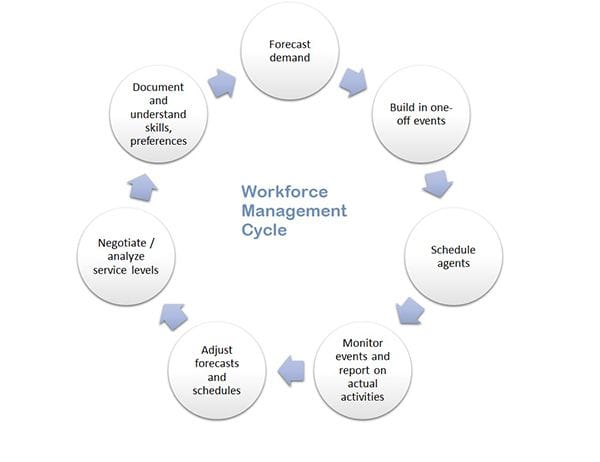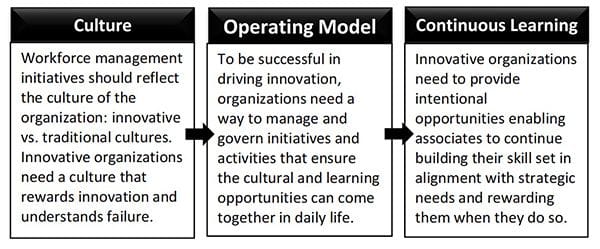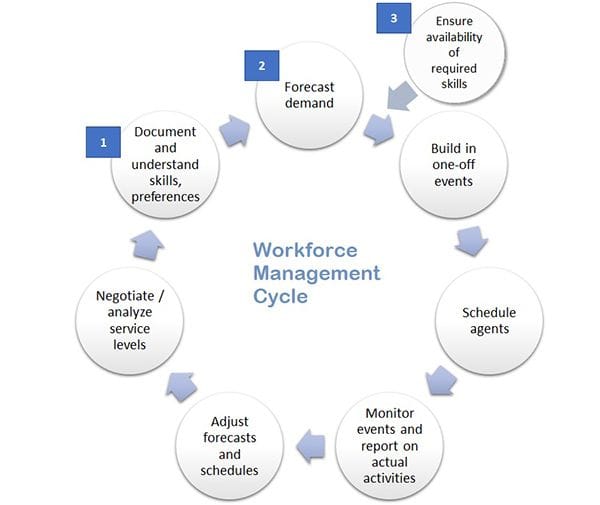Workforce management focuses on ensuring you have enough people to staff the phones, do the daily work, and so forth, right? Almost. Workforce management also includes having the right people on staff to do the work you need done today and the work you’d like to have done tomorrow. In short, workforce management in today’s digital experience-driven world means having people that are able to bring innovative ideas and technology to the workforce and having people that can operate those environments once they are established.
Understanding the Workforce Management Gap
Workforce management generally focuses on using predictive metrics to determine the number of people needed to staff various shifts and is often used to manage support center staffing. While this is a valid and necessary area for using workforce management, it is also intended to be a strategic tool that organizations use to ensure they have the capabilities needed to mature and innovate.

ContactBabel, a consultancy in the call center industry, has documented a workforce management cycle referenced as an industry standard that makes it easy to manage the workforce using management tools. It’s easy for workforce managers to fall into the trap of documenting and managing the skills needed for today’s operational needs, not projecting the skills needed for innovation. The result can be stagnation of services, especially when people get comfortable with their own skills and fail to grow.
Another gap with workforce management is that it is often performed in environments like support centers, logistics/warehousing, assembly, and other transactional areas, rather than at an enterprise level. When performed across an organization and aligned with the organization’s strategy, workforce management can offer additional capabilities needed by the modern organization to achieve true digital transformation.
Building an Innovative Workforce
There are three “pillars” to look at when starting a strategic workforce management initiative tied to innovation:

When creating a strategic workforce management initiative intended to support innovation, a culture of innovation must first be present in the organization. To achieve this, it’s important to encourage innovative activities and assume that sometimes failure will result. Innovation will never be achieved in a “blame culture.” Rather, people need to be free to fail, recover, and try again. If an innovative culture is not present, this should be addressed first through an organizational change management initiative focused on creating one.
Once an innovative culture is in place from the top-down within the organization, operating models that include support for innovation and continuous learning can then be created. In fact, operating models can be used throughout the initiative as they create the foundation for how people perform their jobs.
When looking at the operating model, it’s important to understand that every organization has an operating model. This term simply refers to the organization’s policies, standards, and procedures, combined with daily activities that enable the organization to carry out its strategy. Even if no operating model has been created, each and every organization is operating under one, even if it’s an ad-hoc collection of informal processes. The term is mainly an expression of how you do business today.
The gap to address is whether the operating model is intentionaldriving the outcomes needed for innovation and strategic successor ad hoc and silo-based, causing outcomes that are not fully aligned with the organization’s strategic intent. In many cases, it’s the latter.
VeriSM TM , a new model for delivering service management in the digital age, provides guidance on developing and leveraging operating models suited to the needs of the organization and what it is seeking to achieve. This approach provides organizations with the ability to link their strategy with policies, procedures, and standards that enable them to be successful. Among other critical success factors, the VeriSM model calls out organizational change management, engagement, and enablement as key factors for success in building an operating model to support innovation in the digital age. VeriSM also provides guidance on combining frameworks, governance, and technology to support the creation and delivery of operating models.
By creating a strategic operating model for the organization, workforce management and organizational change management teams can begin the work of shifting the organization from silo-based models to an organization-based operating model that supports a culture of innovation and uses governance to drive intended outcomes. The workforce management aspect of this work should focus on several areas:
- Understanding and documenting gaps between current skill sets and the skill sets needed to deliver the innovative services being planned by the organization
- Creating programs for enhancing skill sets through continuous learning and rewarding associates for achieving skills needed by the organization
- Ensuring that the organization has the right number of people available to design and build innovative solutions as well as supporting those solutions once operational (taking workforce management beyond the support center)
- Adopting and supporting a culture of knowledge sharing that ensures information needed to support these new services is available to end users and support teams
These should be embedded in the policies and procedures of the organization and supported by the governance structure that ensures management of these activities.
Additionally, the resulting operating model changes the workforce management cycle slightly by adding a new step.

After documenting and understanding the skills needed and forecasting demand, there needs to be an additional step of ensuring the availability of required skills as shown the updated diagram.
One way to ensure that workforce management supports the strategic needs of the organization is to embed it in the strategic process, engaging the team at the start of the process.
When the organization first looks at innovative technologies it might want to employ in future goods or services, workforce management should begin the first three steps shown above so that training programs can be found, and associates can be provided with the opportunity to grow the new skills needed. If talent also needs to be acquired, this is the point at which that process should begin.
These processes should be embedded in the operating model of the organization, ensuring this engagement occurs regularly, thus enabling growth and development of the workforce required to perform the innovative work of the organization.
This approach will provide positive impact in employee engagement and retention that supports the organization’s need to provide innovative solutions to its customers. Enabling people to continue to grow and learn new technologies provides them with a feeling of accomplishment and loyalty to the organization that’s helping them grow. It also increases their desire to take on new challenges as the organization continues to grow.









